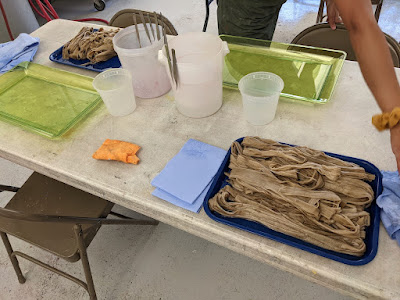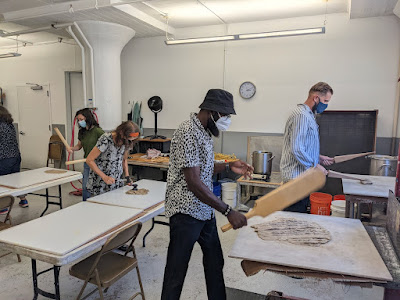I will save more of these pics for later but was happy to see giant milkweed doing fine in containers (maybe they don't over years but this was heartening, as I was worried they would not thrive...then again, I'm sure there is a team of landscapers who keep the whole place happy). State College landed in the X at the middle of PA and will bookend my trip to NY; I drive back there tomorrow morning for a farm visit.
I was grateful to break up the trip into two days, as I always dread the drive from OH to NY. I know it's nothing to drivers who like road trips but my body is not built for it. I had one day to rest and then got a ride into Brooklyn to start class prep. I tricked myself into thinking I'd be there for an hour but of course that was not the case as we had a whole new hanji vat born into the world to set up! This pond liner, we discovered, was not the trick, but it survived class. Plus, with two teachers, we had to be mindful about how each room was prepared.
I stayed around the corner from Spike Lee's studio in an Airbnb that was in a fantastic location but not conducive to sleep. It didn't help that I hadn't slept the night before I started driving from a meat attack (since late May, I've discovered 7x that I cannot eat red meat), and didn't sleep much the following nights. Somehow I can still teach on fumes but I'm paying the price now with all kinds of screaming from my body. But it was an easy mile walk to work and close to friends I could visit with in the evenings.
I was so glad that Joko flew in from Puerto Rico to assist; she had never been to Dieu Donné before but was like an old pro from the moment we began, getting what we needed before we asked. She had emailed me in 2017 and had visited my first hanji teacher's mill while studying Korean art and language for a year in Korea. I don't know if it was my own racism or weariness at the time fielding cold calls in between traveling the world, but I encouraged her to contact a colleague (AKA passing the buck). I should have been more helpful, but then she surprised me by showing up at a class in Cleveland that year. Once I met her in person I realized, this is the real deal, she is very serious—and wonderful. I was worried sick when Hurricane Maria devastated the island, advised her to do a winter internship in Cleveland, and watched her thru the grad school application process, moving to Iowa, and returning to PR to do exactly what she said she wanted to do: expand book arts at home. Her true dedication to this long-term goal is so remarkable, while being a loving and delightful human being.
When Tatiana asked me to co-teach with her, she thought we could do a version of our first team teaching at Oberlin. But I said, given the resources of Dieu Donné, what if we provided a comparative study of hanji and washi by setting up side-by-side Korean and Japanese vats? That meant that DD had to build a hanji vat, which they did. Given the similarities in fiber prep, we could start together on the first day cleaning and beating fiber, and then split into successive demos. I was so excited to finally be able to show this to people directly instead of showing videos or miming. Our students above are picking fiber after a light rinse.
I joked to Tatiana that we were likely getting more out of class than our students because we were sharing info that could easily go over the heads of grad students, info that was incredibly exciting to each other. She rinses differently from me, and these are the details that are so insightful to share: she does a light rinse to keep fibers more intact to make picking easier. In fact, because we worked with Thai kozo (which is notoriously tough), they were picking less and instead scraping off the top layer, which made for clean and usable fiber very quickly. It was like a combo of two steps because we don't have control over the scraping step; it happens in Thailand by laborers that we will never meet.
I set up a cursory picking vat to mimic what Korean ladies do well into their 80s. It was a luxury to be in a real paper studio that is fully outfitted so that it was easy to locate extra equipment to do spur of the moment things. The space has changed drastically—for the better—from when I helped with their community studio (no longer part of their programming) and it was heartening to see the org going in the right direction to fully support its staff and artists.
Cleaned fiber! A DD staff member, Katharine, also helped throughout, so in combination with Joko I would be amazed to walk into a fully cleaned or prepped studio at various segments of class because they would have set things up. Because Tatiana works there, she took on the heavy lifting of prep alongside the staff and interns prior to my arrival, which was another luxury (yet it shouldn't be for teachers! This is how high I want the bar to be everywhere).
Tatiana is also very serious about giving students lots of context. I am trying to leave behind my ways of bringing an entire exhibition to my teaching gigs, so it was great to see what she brings along to her classes. We did slides and videos as well, and all of this was A LOT given we only had three days. It's amazing that we covered so much ground and only went over about 10-15 minutes on the last two days.
After lunch on Day 1, we started beating, and it was not the first time during class that I felt guilty for not bringing more of my tools. But we managed even with rotating duties.
At some point, wishing for more beating tools, I ran to the other room to get the hanji couching log to see if the PVC piping would work as a beater, and it did! Teaching in unfamiliar locations keeps you on your toes. I am always surprised when papermaking studios aren't equipped for both European/American and East Asian papermaking, only because my first experience was in a studio that did. But it's easy I guess to go hard in one direction as all versions go deep.
On Day 2, I demoed the hanji vat and then Tatiana her washi vat. We were so glad to see how well the class cleaned and beat the fiber. Both of us usually worry that students are impatient to get to sheet forming, and I often rush to that step. But after seeing how well my hanji retreat at home went, it confirmed that anyone who wants to learn this type of papermaking HAS to know that only 10% of it is the "fun" part. Fiber prep is everything, and it's worth spending a third of class doing it. The paper ends up being much nicer in the end.
On Day 3, I got to the studio early (fortunately, I had already set off the alarm on Day 1 and couldn't turn it off, so I had the code to prevent that. Setting off of alarms, along with forgetting about live fires, is my great talent) to get a post going. It required more sheets than at home because of the nature of the boards and felts, so by the time students started to arrive, I left Joko to pad the post. We definitely had lots of losses in the stack that day because students were still learning but did our best using extra fiber to fill the valleys.
Parting was a trip because we overpressed both days, only because we had never tried hanji in this press. Now we know better.
This was a group effort at vat agitation because students were eager to get going. I don't blame them, since there was only one hanji vat but 2-3 washi vats and 4 sugetas versus 1 bal. I have thought over the years about how to create student versions of the professional screen, but I couldn't figure out it and instead sacrifice my own tools that are hundreds of dollars. But better that the last bal maker in Korea has many hands use his handiwork, right?
On the second day, each student got to make one sheet of hanji (which is actually two cycles at the vat since each sheet is 2-ply). On the third day, I wanted everyone to make two sheets (four times at the vat) because that would help them finally get the feel a little better. The balance is tricky, because I have to stay long enough to know they won't destroy the tools and growing post of paper. But then I have to leave them alone because it isn't helpful to have a teacher hovering as you try to sort things out. Here I am lurking behind Gerard, who was so happy to make sheet after sheet.
Here is Joko's shot to prove that I didn't abandon my students. I forgot to ask her to take a posed picture of Tatiana and me.
So this proves that we were in the same room together!
This likely looks like no big deal, but to me it is a dream come true!! Sarah is making washi in the foreground and Jarrod is making hanji. Speaking of people who respond nicely to cold emails (I usually am quite good and I have a better handle on the constant inquiries): I emailed Tatiana 15 years ago for advice as I prepared my first Fulbright application (she had been to Japan for two years on the same grant). She was very generous to me, a stranger. We met in person 10 years ago, and taught together for the first time 7 years ago. She has been unflagging, as steadfast and calm and patient and grounded as the first time I've interacted with her, and it was excellent and non-stressful to teach with her. I had heard for years about how incredible of a teacher she was, so it was an honor to hear her tell the class that she felt privileged to teach with me. The feeling is extremely mutual; I was entirely supported throughout all of the steps: conception, planning, execution, and follow-up. We had a fantastic group of truly engaged and dedicated students; I only wish we had had more time together + more sleep.
All I want going forward in my teaching experiences is a deepening of my ability to do it effectively, to be aware of what is going on at level of subtlety I couldn't have imagined when I began. The tricky thing is that I can feel the travel and logistics taking a much bigger toll. So the revision is to get better at teaching while simultaneously getting better at taking care of myself.





















No comments:
Post a Comment